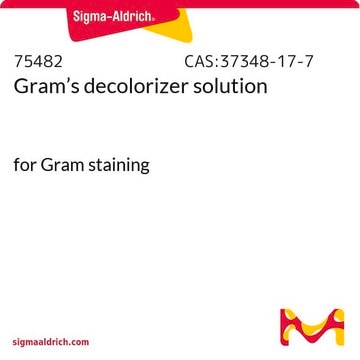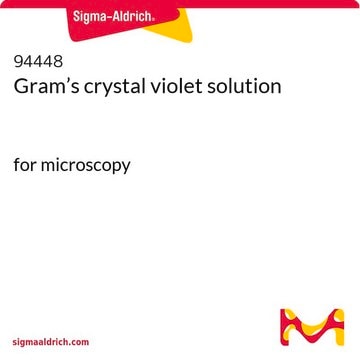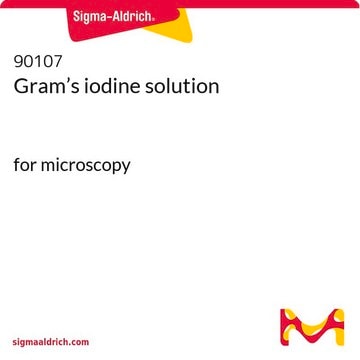94635
Gram′s safranin solution
for microscopy
Synonym(s):
Safranin T solution
About This Item
Recommended Products
grade
for microscopy
Quality Level
form
liquid
shelf life
limited shelf life, expiry date on the label
composition
ethanol, 10%
technique(s)
microbe id | staining: suitable
color
red to very dark red
refractive index
n20/D 1.339
solubility
water: soluble at 20 °C
density
0.986 g/mL at 20 °C
εmax
4.0 at 532 nm in 50% ethanol
antibiotic activity spectrum
Gram-negative bacteria
Gram-positive bacteria
application(s)
diagnostic assay manufacturing
hematology
histology
storage temp.
room temp
SMILES string
[Cl-].Cc1cc2nc3cc(C)c(N)cc3[n+](-c4ccccc4)c2cc1N
InChI
1S/C20H18N4.ClH/c1-12-8-17-19(10-15(12)21)24(14-6-4-3-5-7-14)20-11-16(22)13(2)9-18(20)23-17;/h3-11H,1-2H3,(H3,21,22);1H
InChI key
OARRHUQTFTUEOS-UHFFFAOYSA-N
Looking for similar products? Visit Product Comparison Guide
General description
Application
- as a non-toxic replacement for crystal violet for the quantification of biofilm formation
- to develop a hyaluronic acid visualization method
- to study improved β-lactam susceptibility against biofilm-embedded staphylococcus aureus by 2-aminothiazole
Features and Benefits
- Ready-to-use solution.
- Modified and designed in such a way that staining can be carried out in staining cells, on the staining rack, and in automated staining systems.
Principle
Signal Word
Warning
Hazard Statements
Precautionary Statements
Hazard Classifications
Flam. Liq. 3
Storage Class Code
3 - Flammable liquids
WGK
WGK 2
Flash Point(F)
114.8 °F
Flash Point(C)
46 °C
Personal Protective Equipment
Choose from one of the most recent versions:
Already Own This Product?
Find documentation for the products that you have recently purchased in the Document Library.
Customers Also Viewed
Our team of scientists has experience in all areas of research including Life Science, Material Science, Chemical Synthesis, Chromatography, Analytical and many others.
Contact Technical Service










